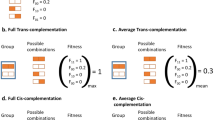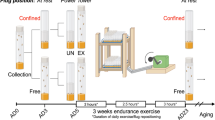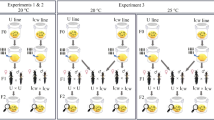Abstract
Cytoplasmic incompatibility (CI) and male-killing (MK) are both examples of the action of selfish cytoplasmic elements. Both are found in a wide variety of host arthropod species and sometimes coexist within the same species. Although classical models suggest that fitness compensation is potentially important in explaining the invasion of the MK cytotype, no model of CI evolution incorporates this effect. We construct a discrete-time mathematical model which describes a host population containing both CI and MK, permitting fitness compensation for survivors of broods which suffer partial mortality as a result of the behaviour of either element. In the absence of fitness compensation, classical models of CI predict the existence of a threshold frequency at which infected individuals must be introduced in order to spread in a wild-type population. We examine whether fitness compensation will affect the ease of spread of CI (reduce the lower threshold) and its equilibrium frequency. Fitness compensation is found to affect the dynamics of CI in a complex manner. This is so, regardless of whether one considers the introduction of individuals infected with the CI element alone, or the introduction of individuals infected with both CI and MK elements into a wild-type population. The model predicts that fitness compensation has only a small effect on the dynamics of CI/wild-type population. In contrast, when individuals infected with both CI and MK agents are introduced into a wild-type population, the presence of plausible levels of fitness compensation may greatly facilitate the spread of CI. We note that this apparent synergism may be expected from the coexistence of CI with other sex-ratio distorters.
Similar content being viewed by others
Article PDF
References
Breeuwer, J A J, and Werren, J H. 1990. Microorgan-isms associated with chromosome destruction and reproductive isolation between two insect species. Nature, 346, 558–560.
Breeuwer, J A J, and Werren, J H. 1993a. Cytoplasmic incompatibility and bacterial density in Nasonia vitripennis. Genetics, 135, 565–574.
Breeuwer, J A J, and Werren, J H. 1993b. Effect of genotype on cytoplasmic incompatibility between two species of Nasonia. Heredity, 70, 428–436.
Fine, P E M. 1978. On the dynamics of symbiote-dependent cytoplasmic incompatibility in Culicine mosquitoes. J Invert Pathol, 30, 10–18.
Hamilton, W. 1964. The genetical evolution of social behaviour I and II. J Theor Biol, 7, 1–16 & 17–52.
Hurst, G D D, and Majerus, M E N. 1993. Why do maternally inherited microorganisms kill males? Heredity, 71, 81–95.
Hurst, G D D, Majerus, M E N, and Walker, L E. 1992. Cytoplasmic male-killing elements in Adalia bipunctata (Linnaeus) (Coleoptera: Coccinellidae). Heredity, 69, 84–91.
Hurst, G D D, Hurst, L D, and Majerus, M E N. 1997. Cytoplasmic sex ratio distorters. In: O'Neil, S. L., Werren, J. H. and Hoffmann, A. A. (eds) Influential Passengers; Inherited Microorganisms and Invertebrate Reproduction. Oxford University Press, Oxford (in press).
Hurst, L D. 1991a. The evolution of cytoplasmic incompatibility or when spite can be successful. J Theor Biol, 148, 269–277.
Hurst, L D. 1991b. The incidences and evolution of cytoplasmic male killers. Proc R Soc Lond, B, 244, 91–99.
Hurst, L D. 1993. The incidences, mechanisms and evolution of cytoplasmic sex ratio distorters in animals. Biol Rev, 68, 121–193.
Hurst, L D, Atlan, A, and Bengtsson, B O. 1996. Genetic conflicts. Q Rev Biol, 71, 317–364.
Rigaud, D, and Juchault, P. 1993. Conflict between feminizing sex ratio distorters and an autosomal masculinizing gene in the terrestrial isopod Armadillidium vulgare Latr. Genetics, 133, 247–252.
Rousset, F, and Raymond, M. 1991. Cytoplasmic incompatibility in insects: why sterilize females? Trends Ecol Evol, 6, 54–57.
Skinner, S W. 1985. Son-killer: a third extrachromosomal factor affecting sex ratio in the parasitoid wasp Nasonia (= Mormoniella) vitripennis. Genetics, 109, 745–754.
Solignac, M, Vautrin, D, and Rousset, F. 1994. Widespread occurrence of the proteobacteria Wolbachia and partial cytoplasmic incompatibility in Drosophila melanogaster. C r Acad Sci Paris Ser III -Sci Vie, 317, 461–470.
Stouthamer, R, Luck, R F, and Hamilton, W D. 1990. Antibiotics cause parthenogenetic Trichogramma (Hymenoptera/Trichogrammatidae) to revert to sex. Proc Natl Acad Sci USA, 87, 2424–2427.
Turelli, M. 1994. Evolution of incompatibility-inducing microbes and their hosts. Evolution, 48, 1500–1513.
Turelli, M, and Hoffmann, A A. 1995. Cytoplasmic incompatibility in Drosophila simulans: dynamics and parameter estimates from natural populations. Genetics, 140, 1319–1338.
Werren, J H. 1987. The coevolution of autosomal and cytoplasmic sex ratio factors. J Theor Biol, 124, 317–334.
Werren, J H, Nur, U, and Wu, C-I. 1988. Selfish genetic elements. Trends Ecol Evol, 3, 297–302.
Werren, J H, Skinner, S W, and Huger, A M. 1986. Male-killing bacteria in a parasitic wasp. Science, 231, 990–992.
Werren, J H, Hurst, G D D, Zhang, W, Breeuwer, J A J, Stouthamer, R, and Majerus, M E N. 1994. Rickettsial relative associated with male-killing in the ladybird beetle (Adalia bipunctata). J Bacteriol, 176, 388–394.
Werren, J H, Zhang, W, and Guo, L R. 1995. Evolution and phylogeny of Wolbachia: reproductive parasites of arthropods. Proc R Soc Lond, B, 261, 55–63.
Williamson, D L, and Poulson, D F. 1979. Sex ratio organisms (Spiroplasmas) of Drosophila. In: Whitcomb, R. F. and Tully, J. G. (eds) The Mycoplasmas, pp. 175–208. Academic Press, New York.
Author information
Authors and Affiliations
Corresponding author
Rights and permissions
About this article
Cite this article
Freeland, S., McCabe, B. Fitness compensation and the evolution of selfish cytoplasmic elements. Heredity 78, 391–402 (1997). https://doi.org/10.1038/hdy.1997.62
Received:
Issue date:
DOI: https://doi.org/10.1038/hdy.1997.62



